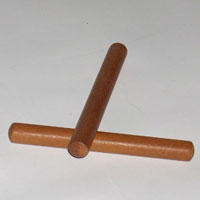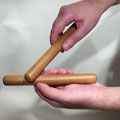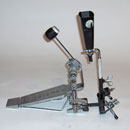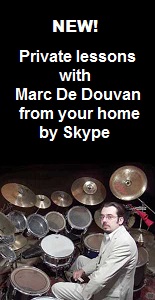
: : : Percussions : : Cuba : Instruments
The clave
 Claves (rosewood)
Claves (rosewood)
The clave or claves, are two cylinders of solid wood struck one against another (usually exotic wood, denser and more resonant (mahogany, teak, rosewood, ebony, etc.) or resin). Perhaps the most primitive percussion instrument (originally two pieces of dead wood, as with the Australian Aborigines), its handling is not so obvious, even if it is similar to hitting one hand against the other.

The clave player must hold the instruments with the fingertips to enhance their resonance. You can also make a hollow with the hand carrying a clave to create a sounding box, and hit with the other as you were held a drumstick. Some claves are asymmetrical, one of them being larger and hollow, with a longitudinal opening (a bit like a "wood block" or an African "log drum" (hollow tree trunk hit by sticks used to communicate from a village to another)).
The Cuban clave rhythm comes from Benin and is developed in a four-beat measure (16 sixteenth notes in 4/4). It is based on the principle of shifting 3 against 4 (as the African beguine or Brazilian bossa nova), that is to say, playing a rhythm in three beats on a four beats rhythm. The only one absolutely repetitive rhythm developing on the duration of one measure, of the Afro-Cuban polyrhythms, it is often used as a point of reference (hence its Cuban name "clave", which means "key" in Spanish). That is why this rhythm is often used as figure of starting or stopping, played by another instrument or in unison.
There are two clave figures which differ only by the shifting of a single note (the third):
- The "Son Clave ": 1231231234121234 (1 corresponds to clave stroke)
- The "Rumba Clave": 1231234123121234
There is another way to vary the clave, given the fact that some of the polyrhythmic rhythms are based on a two beats measure (biguine, tumbao, rumba, etc ...). This is called playing "in reverse", by shifting the rhythm from one half of a 4/4 measure. So, the two claves start then with a rest:
- The "Son Clave " gives therefore: bbababbbabbabbab (b = rest; a = stroke)
- The "Rumba Clave": bbababbbabbabbba
This distinction is also called by counting the number of beats per measure 2/4 (with two beats): clave 3-2 or 3+2, in the normal case, and 2-3 or 2+3, for the reversed (or inverted) clave (some write 2:3 or 2/3 but writing as a fraction can be confused with a time signature, which is really a fraction).
Another way of thinking the clave is to condense the subdivisions of time to play it faster. This concept is also present in Mandingo and Maghreb music which frequently use the progressive accelerando. Instead of decompose each beat with four sixteenth notes, it is divided into three eighth notes in triplet (the Son clave 3+2 for example, becomes: 121212312123).

Some timbales players play clave rhythms on a "wood-block" or a cowbell in independence (as "Changuito" ), and some modern drummers play the clave with the left foot on a bell or a "jam-block" mounted on stand, and beaten by bass drum pedal (Horacio "El Negro" Hernandez , Akira Jimbo , Robby Ameen , Alex Acuna or myself (listen to two solos: one audio from 2004 and one video from 2016)). The initiator of this technique seems to be again Tito Puente , who also played modern drumset, as it is shown in the method that was dedicated to him just before his death ("Tito Puente's Drumming with the Mambo King" Tito Puente and Jim Payne, Hudson Music, 2000, published in English only ).
My drumset method for advanced level "Retour aux sources" ("Return To The Sources ", 2008) devotes an entire chapter to master the playing with left foot clave, with lots of original transcription of this playing by Horacio Hernandez (not present in his method, with an analysis of his video at the 1997 Modern Drummer Festival, in duet with John Patitucci) but also a new pedagogical approach and original musical patterns from my own practice.
Audio demos:
- Son Clave 3+2
- Rumba Clave 3+2
- Son Clave 2+3
- Rumba Clave 2+3
- Ternary Son Clave 3+2
- Ternary Rumba clave 3+2
- Ternary Son Clave 2+3
- Ternary Rumba Clave 2+3
Marc De Douvan, November 2005, translation in English: May 2013.
© 2005 Marc de Douvan Crédits Mentions légales
